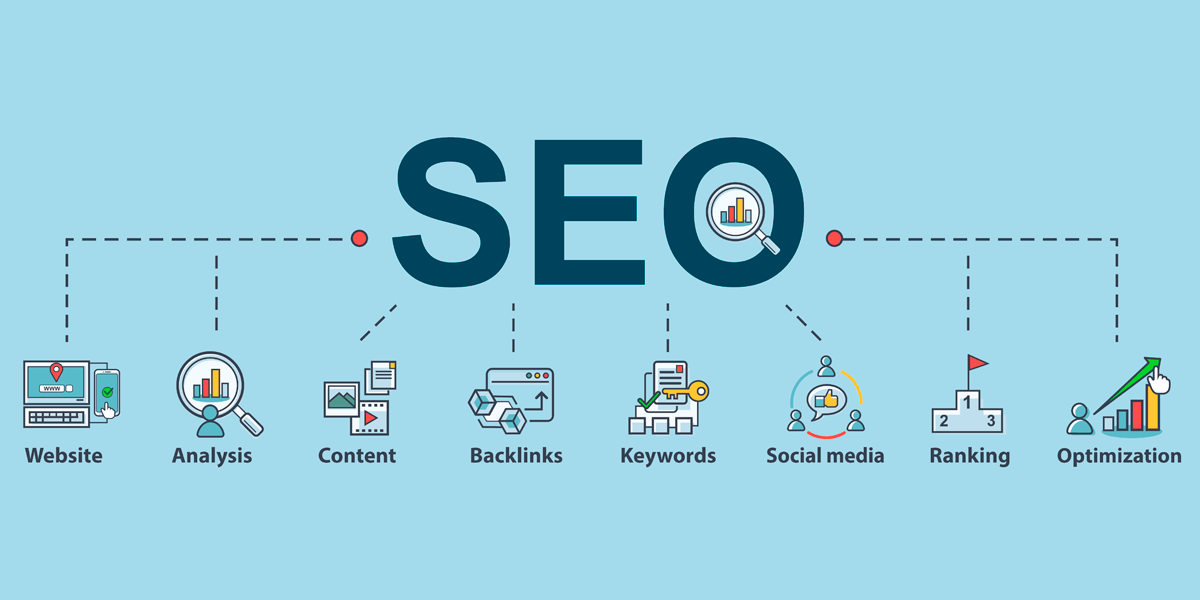Search Engine Optimization (SEO)
1.SEO refers to optimizing your websites and content to rank higher on search engine results pages (SERPs) SEO can be broken down into:
- On-page SEO: optimizing content, title tags, meta descriptions, and Keyword usage on your website.
- Off-page SEO: building backlinks through guest blogging, influencer outreach, and social sharing.
- Technical SEO: Ensuring that your website has a clean code, fast loading speed, and mobile optimization.
- Local SEO: optimizing for location-based searches such as “restaurants near me,” by claiming and optimizing your Google My business listing.
SEO remains one of the most critical components of digital marketing. With voice search gaining traction, optimizing for natural languages and long tail keywords is essential.
2.Off-page SEO refers to actions taken outside of your own website to impact your rankings within SERPs. This includes:
- Backlinks: Acquiring high-quality backlinks from reputable websites to improve your site’s authority.
- Social Signals: Encouraging social media shares and engagement to drive traffic and signals to search engines Content is the backbone of digital marketing. It refers to the creation and distribution of valuable and relevant content to attract, engage and retain customers. The types of content include
Content is the backbone of digital marketing. It refers to the creation and distribution of valuable and relevant content to attract, engage and retain customers. The types of content include:
- Blogging : regular blog posts help businesses rank on search engines, drive traffic and establish authority in their field.
- Video: videos have become one of the most engaging forms of content. Platforms like YouTube , Instagram and allow businesses to share tutorials, product demos, and behind the- scenes content.
- Podcast : with the rise of voice- activated devices, podcasts are gaining traction as an effective way to deliver content on-the-go.
- Infographics: visual representations of data are shared widely on social media and can improve engagement.
Content marketing involves crafting a strategy that aligns with the interests and pain points of your target audience. It helps to build trust, ultimately driving conversions.
3. Social Media Marketing
Social media marketing uses platforms like Facebook, Instagram, Twitter, and Linkedin to engage with users. This marketing focuses on:
- Brand Awareness: social media platforms provide businesses with an opportunity to showcase their brand personality and gain recognition among their target audience.
- Paid Ads: platforms like Facebook, Instagram, and Linkedin allow businesses to run paid campaigns. These ads can be highly targeted, ensuring they reach the right audience based on factors like age, location, interests, and behavior.
- Influencer Marketing: brands collaborate with influencers individuals who have a large and engaged following to promote their products or services.
Social media marketing is one of the most powerful tools for building community engagement and increasing conversions.
4. Technical SEO
Technical SEO involves optimizing the technical aspects of your website to improve its performance. This includes:
- Site Speed: Ensuring that your website loads quickly to enhance user experience and reduce bounce rates.
- Mobile-Friendliness: Making sure your site is responsive and looks good on all devices.
- XML Sitemaps: Creating and submitting XML sitemaps to help search engines crawl and index your site.
5. Pay-Per-Click (PPC) Advertising
PPC is a paid marketing model where advertisers pay for each click on their ads.
- Google ads: search, display and YouTube advertising.
- Social Media ads: Facebook, Instagram, Linkedin, Twitter ad campaigns.
- Native advertising : Paid promotions within third-party content platforms.
6. Email Marketing
Email marketing remains an effective strategy for lead nurturing and customer retention.
- Segmentation and personalization:
Customizing emails based on user behavior.
- Automated campaign: drip campaigns, abandoned cart emails, and engagement strategies.
- Newsletters and promotions: regular updates to keep customers engaged.
7. Affiliate Marketing
Affiliate marketing involves promoting products through third-party affiliates who earn commissions for sales generated.
- Performance- based Rewards: payment is made based on actual conversions.
- Wider Reach: utilizing influencers and bloggers.
- Cost Efficiency: paying for results rather than exposure.
8. Influencer Marketing
Collaborating with influencers allows brands to tap into established audiences .
- Micro-Influencer: Niche marketing through smaller, engaged followings.
- Celebrity Endorsements: High-impact campaign with major personalities.
9. Mobile Marketing
With the rise of smartphones, mobile marketing has become essential.
- SMS and Push Notifications: Direct user engagement.
- location-Based Targeting: Delivering personalized offers to local customers.
- App-Based Marketing : promoting services via apps.
10. Marketing Automation
Automation helps businesses scale their marketing efforts efficiently.
- Chatbots and AI Assistant : instant customer service responses.
- Automated Email Sequences: Enhancing lead nurturing.
- AI-powered content Recommendations:
Personalized user experiences.
11. Data Analytics and performance Tracking
Tracking key performance indicators (KPIs) is crucial for digital marketing success.
- Conversion Rate: The percentage of users completing desired actions.
- Customers Lifetime Value (CLV) : long term profitability assessment.
- Bounce Rate: Evaluating engagement levels on web pages.
12. Strategies for Effective Digital Marketing
Establish specific goals such as lead generation brand awareness, or sales conversion.
- Understand the Customer Target Audience:
Use customer personas and market research to tailor campaigns effectively
- Implement a Multi-Channel Approach:
Utilize a combination of SEO, social media, PPC and email marketing for holistic strategy.
- Focus on Personalization:
Leverage AI and data analytics to deliver customized experiences to customers.
- Ensure Consistent Branding:
Maintain a cohesive brand image across all digital touchpoints.
- Optimize for Mobile Users :
With mobile browsing surpassing desktop usage, ensuring mobile compatibility is essential.
- Use AI and Machine Learning:
AI-powered tools provide better targeting, predictive analytics, and automation.
